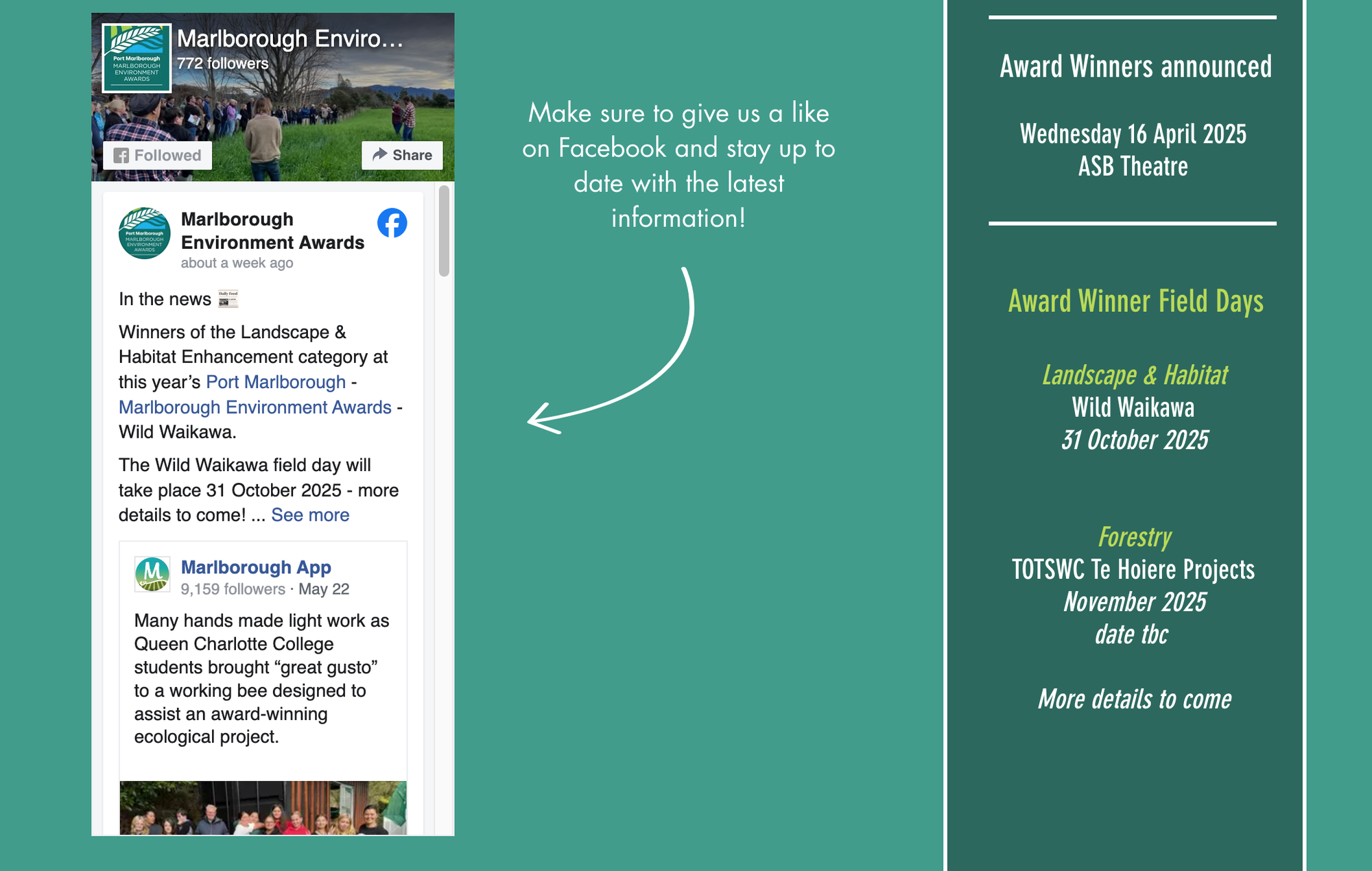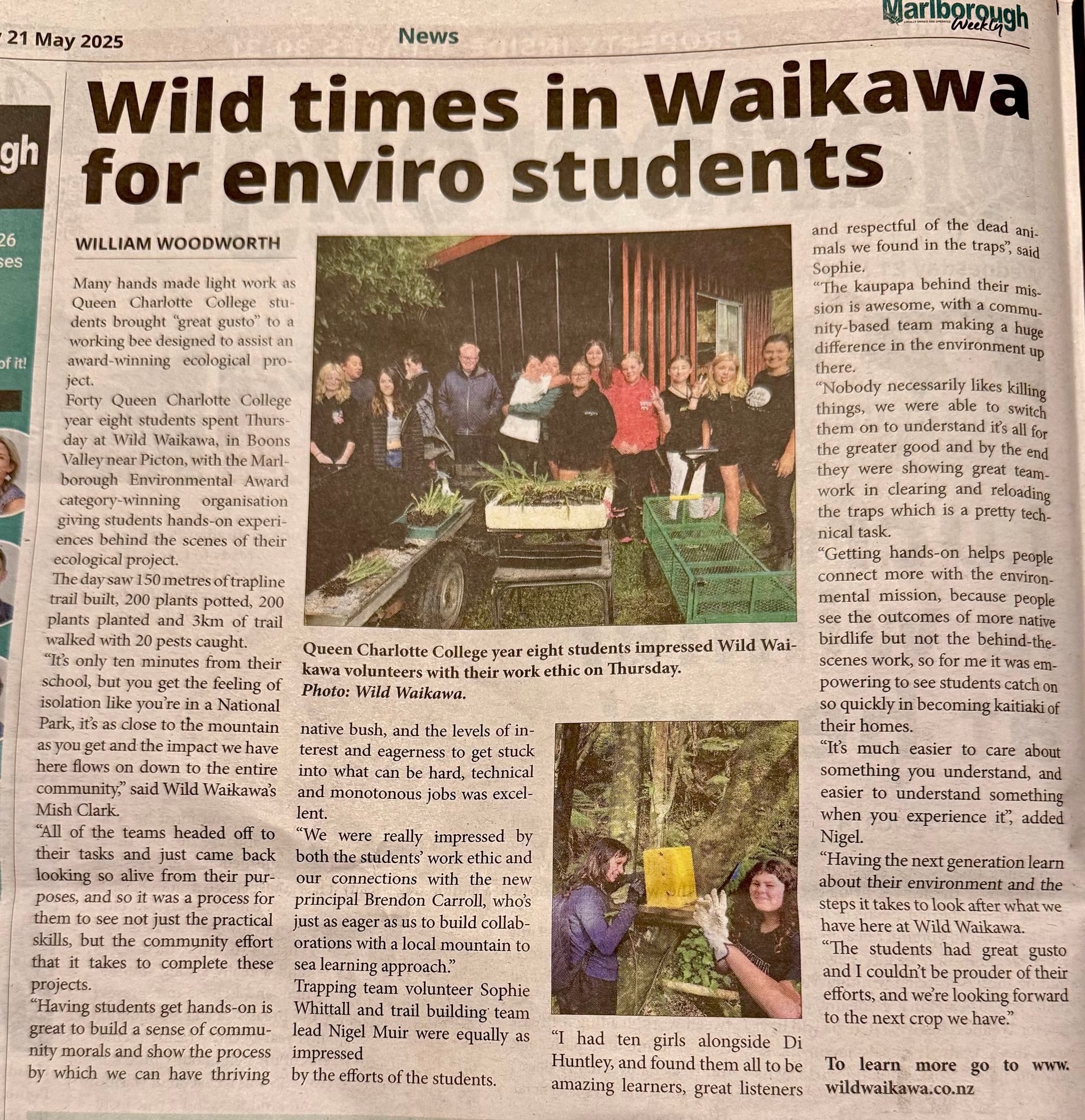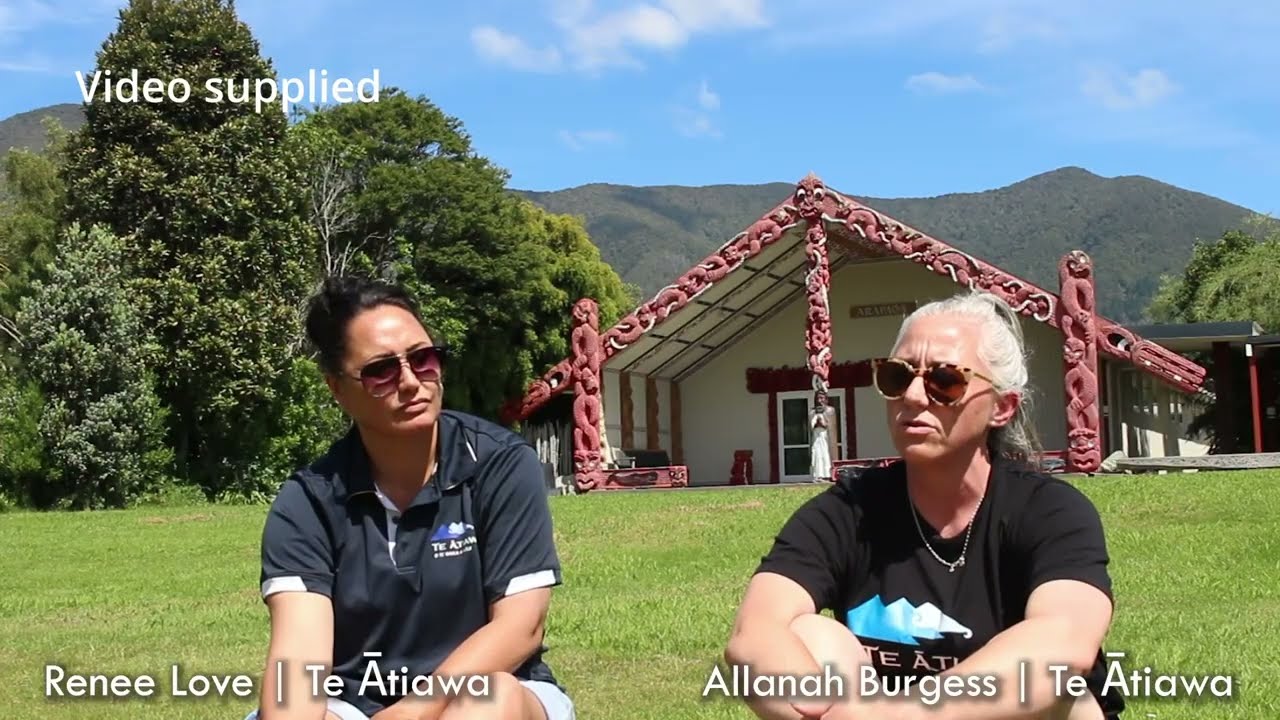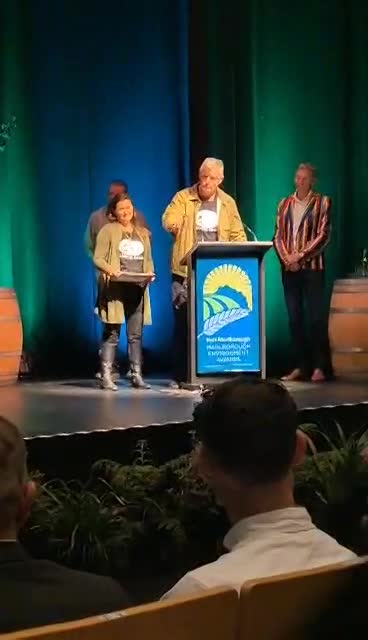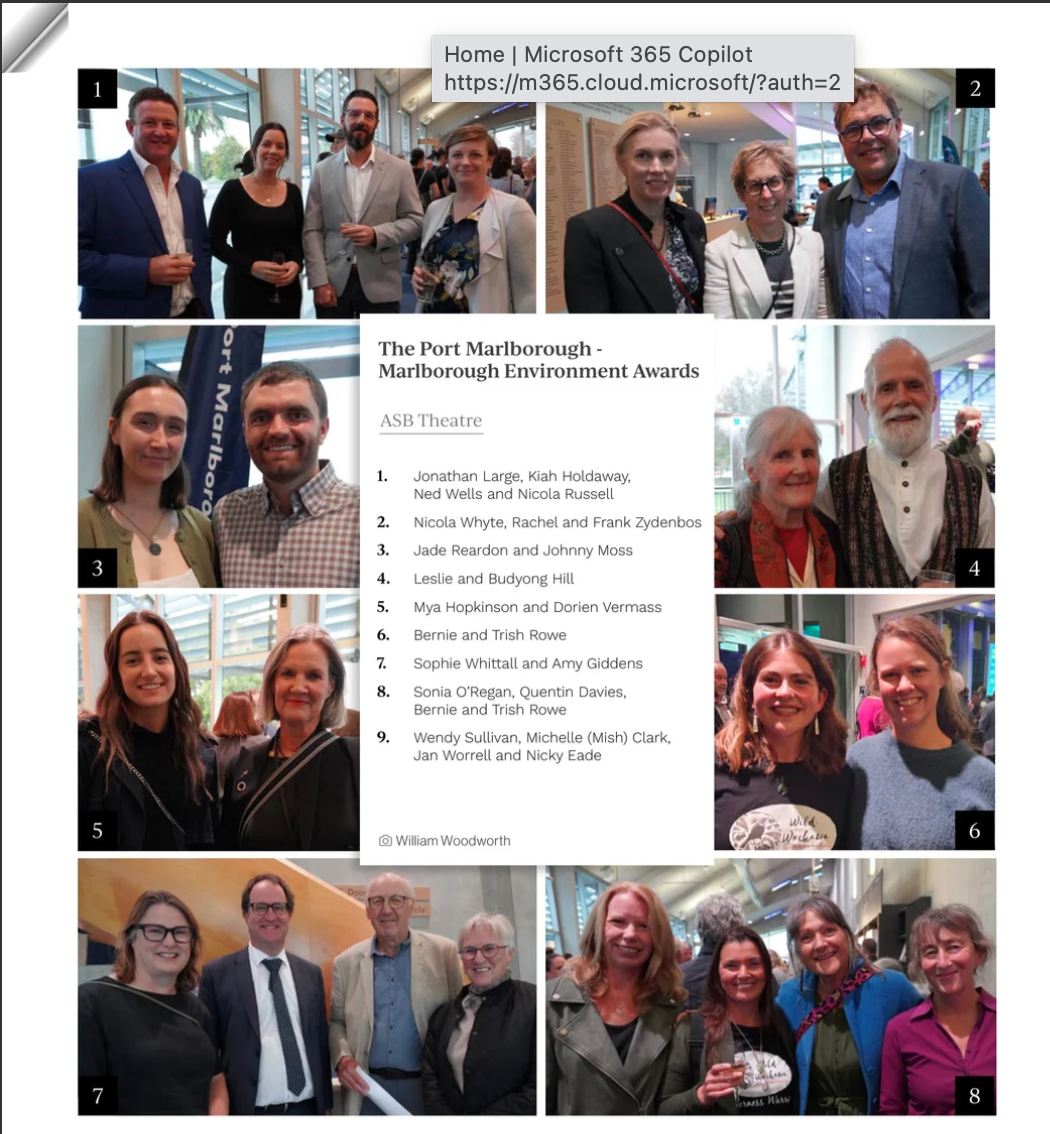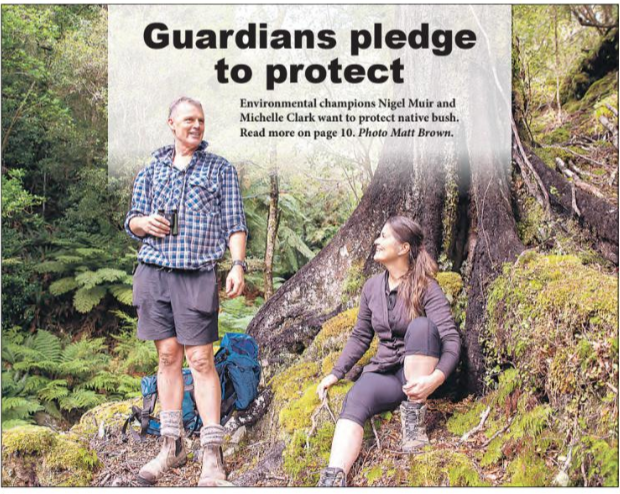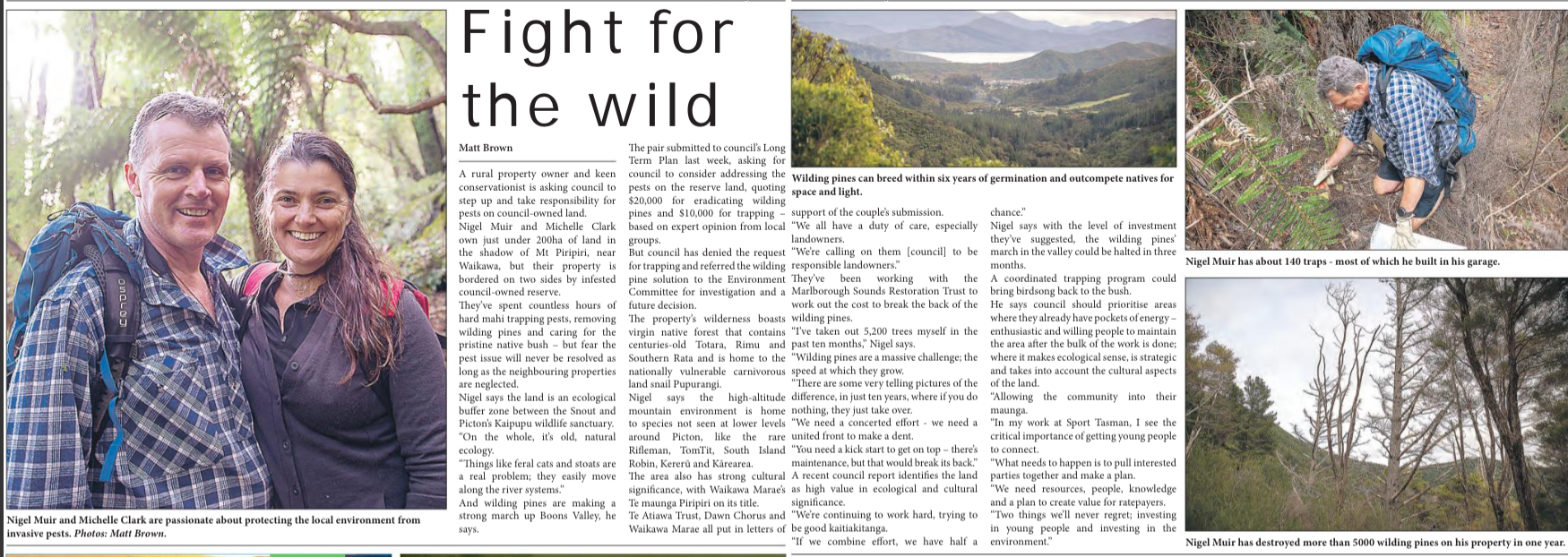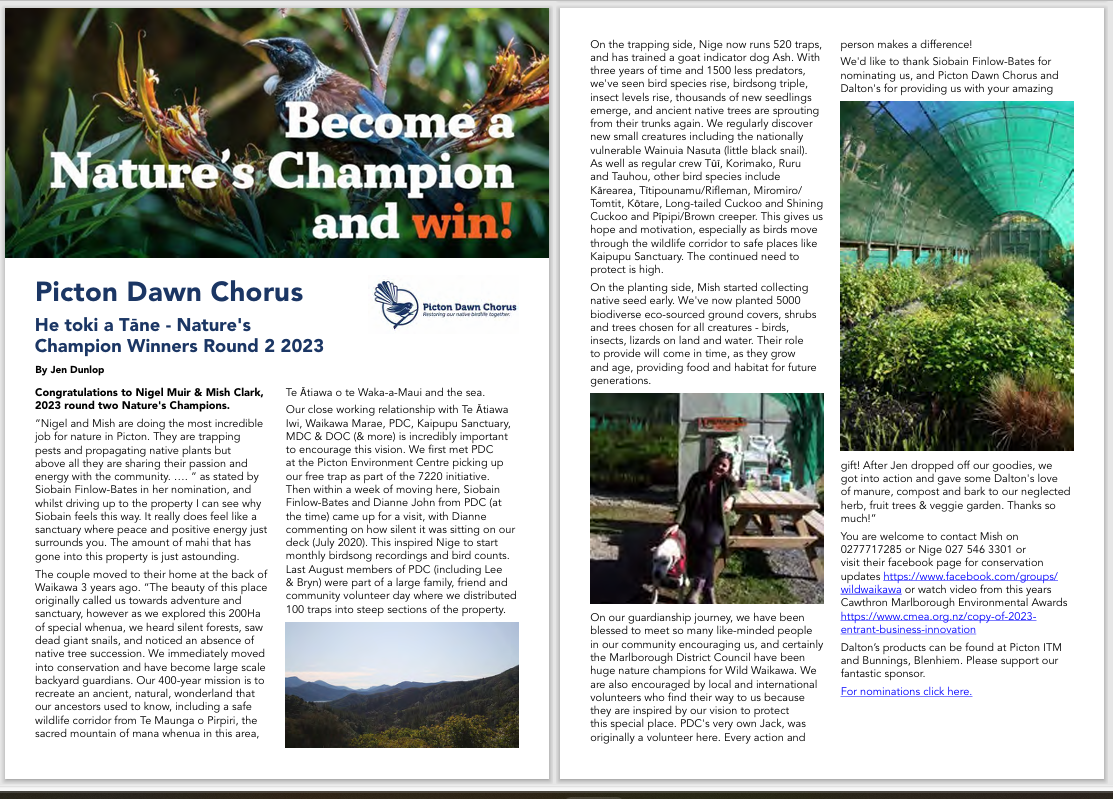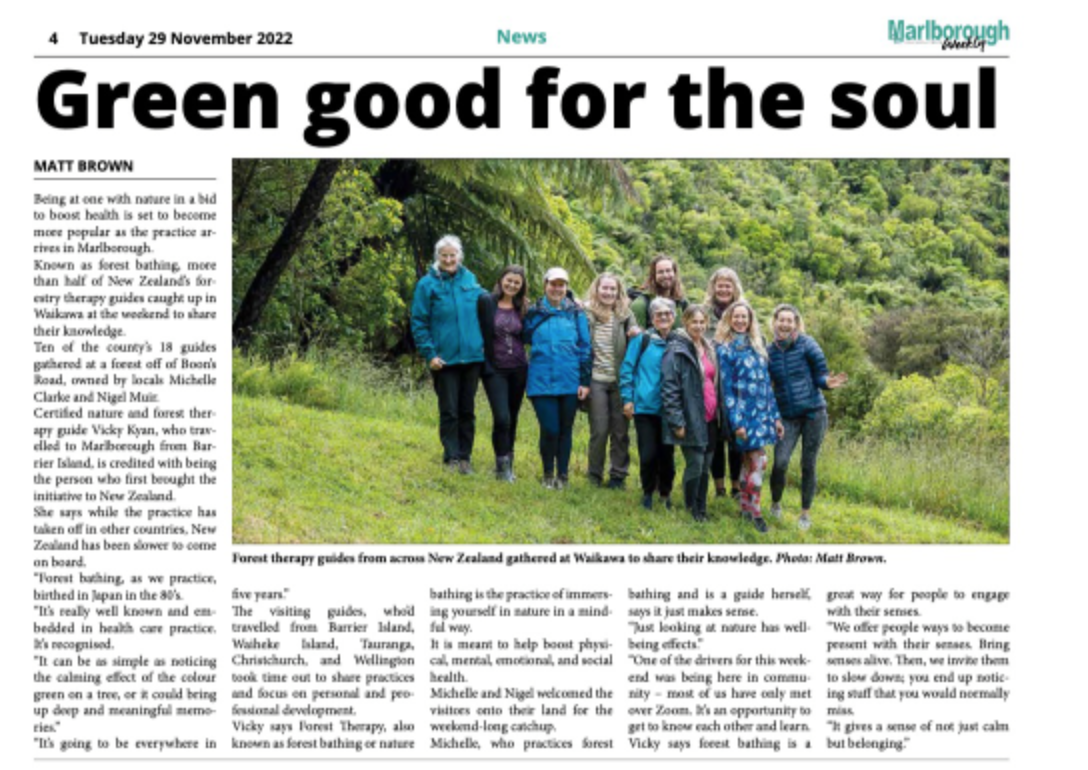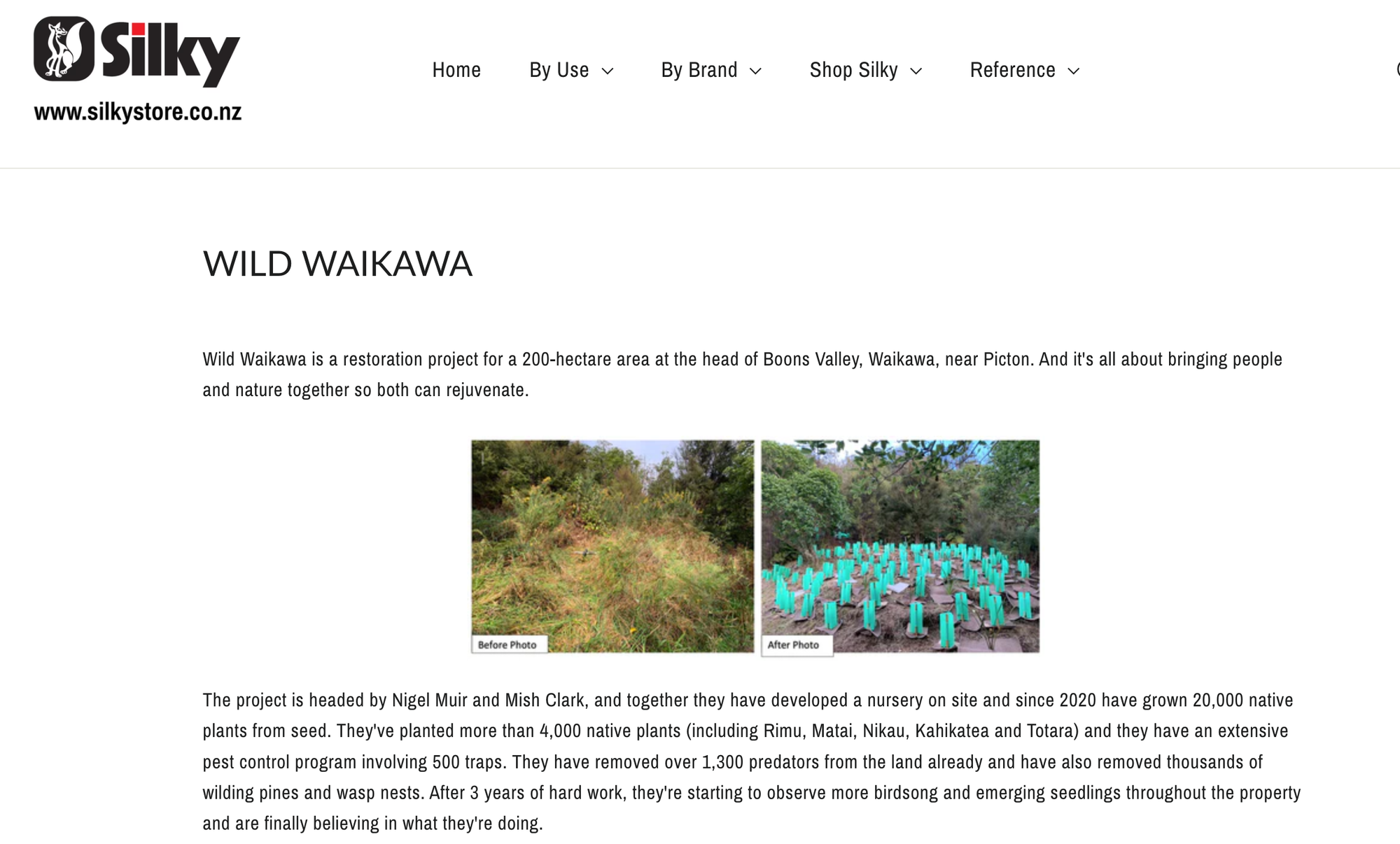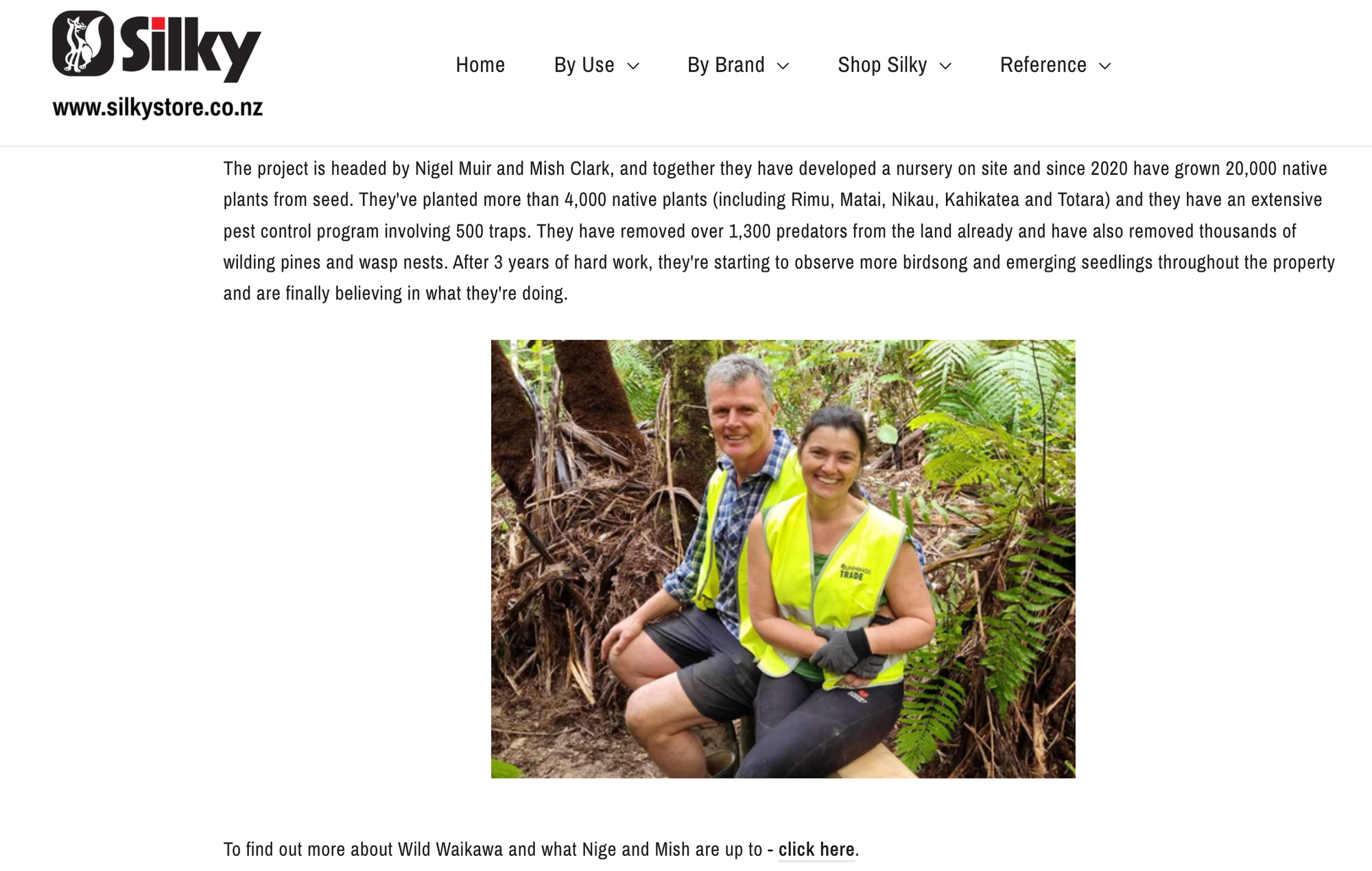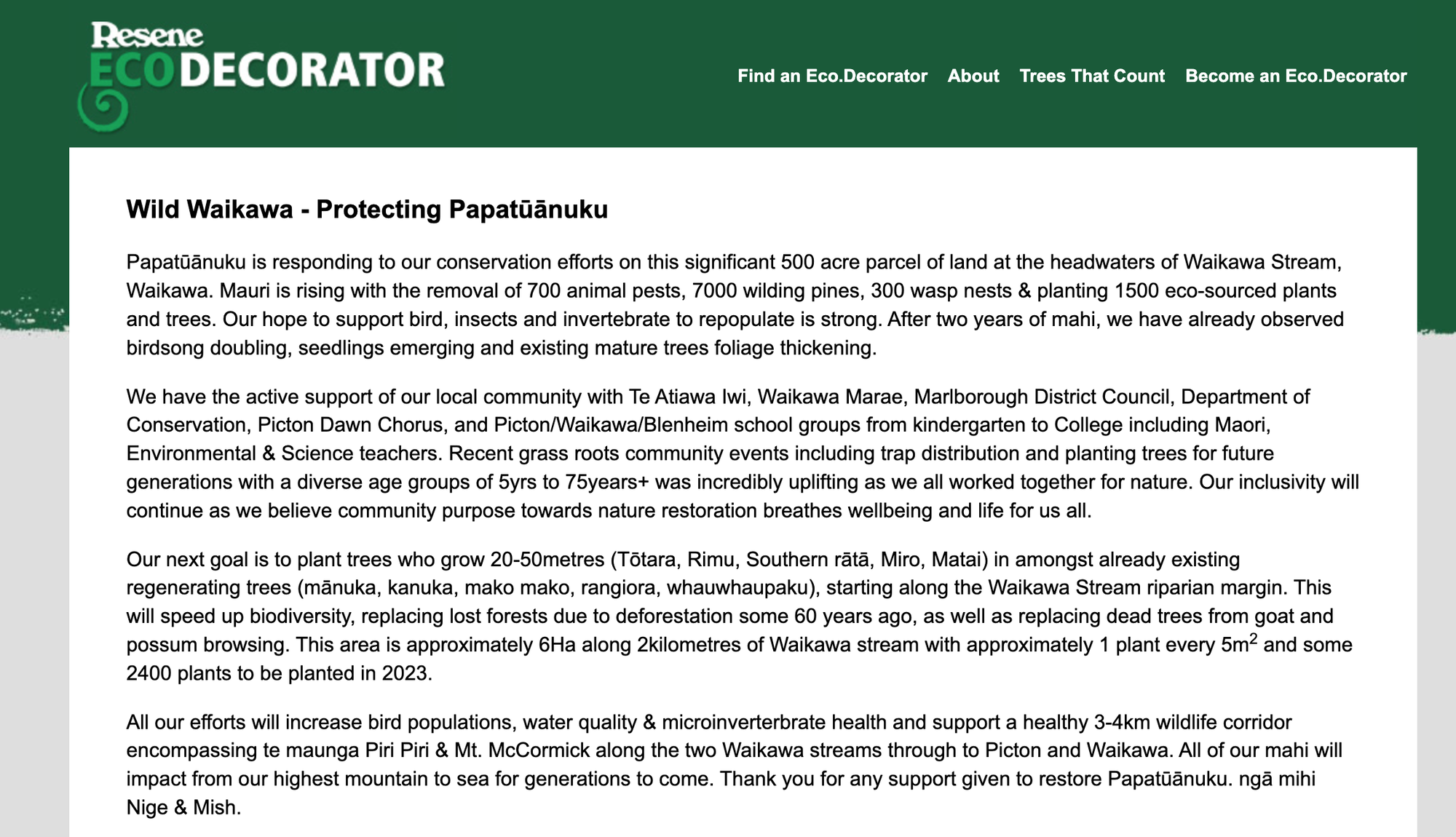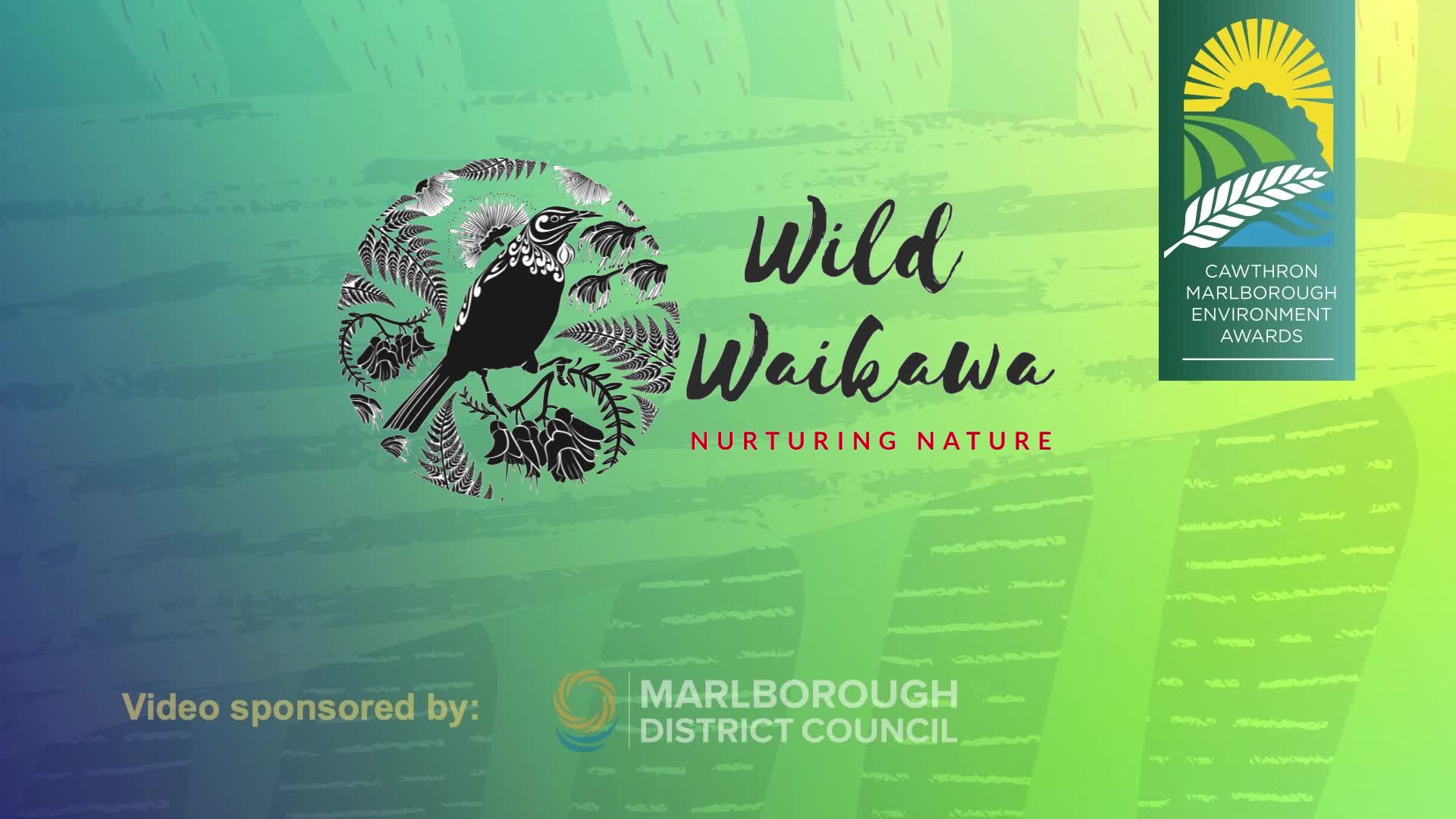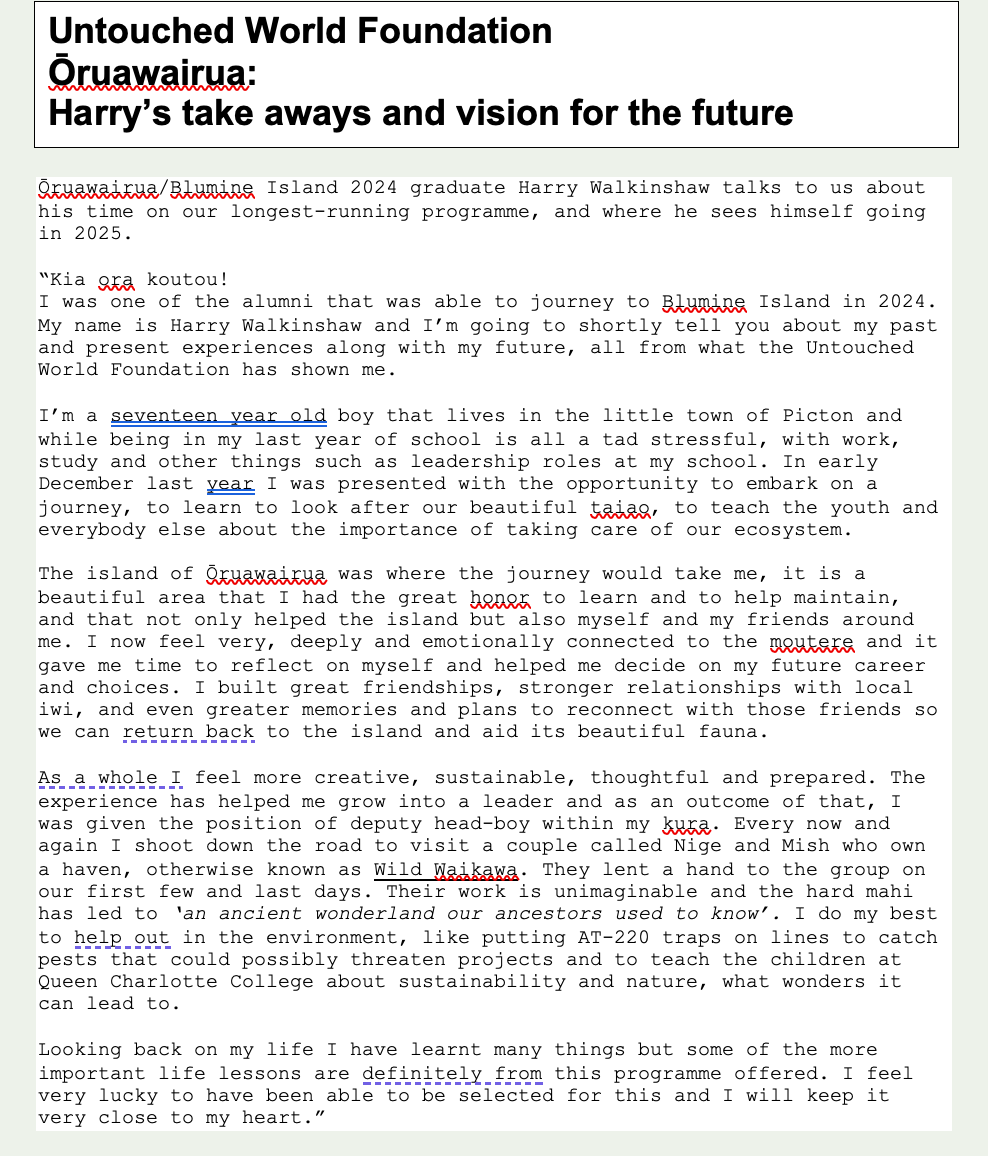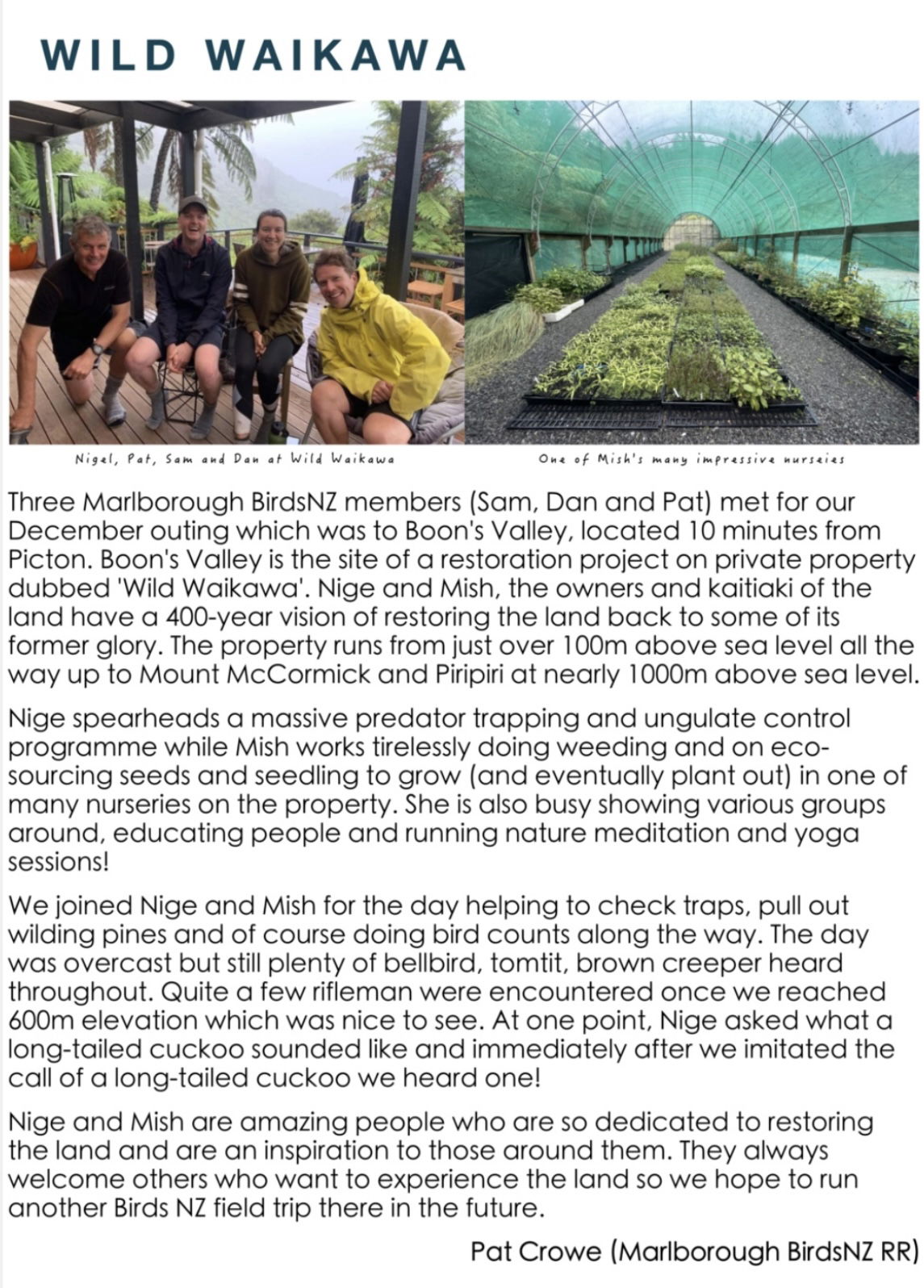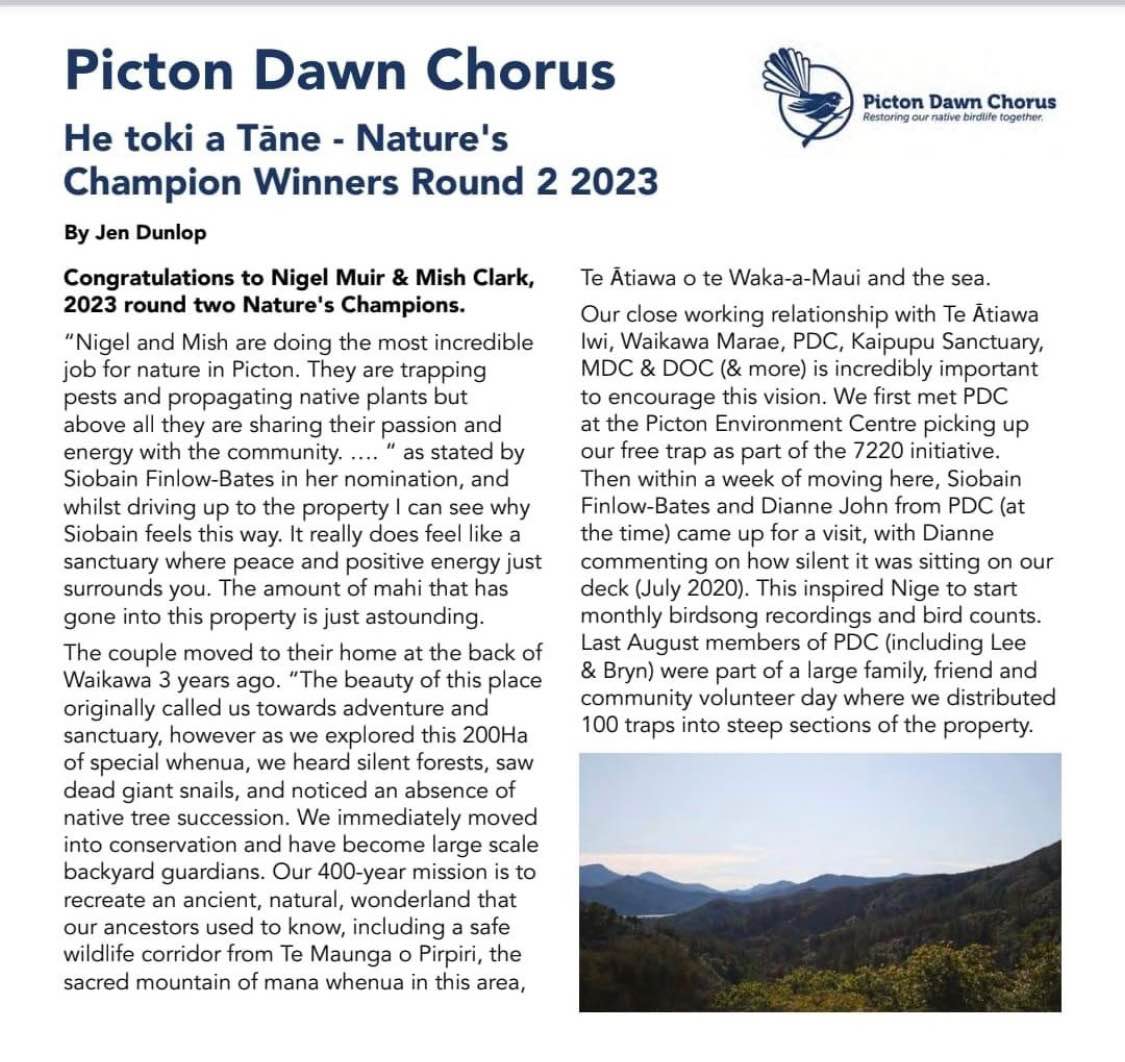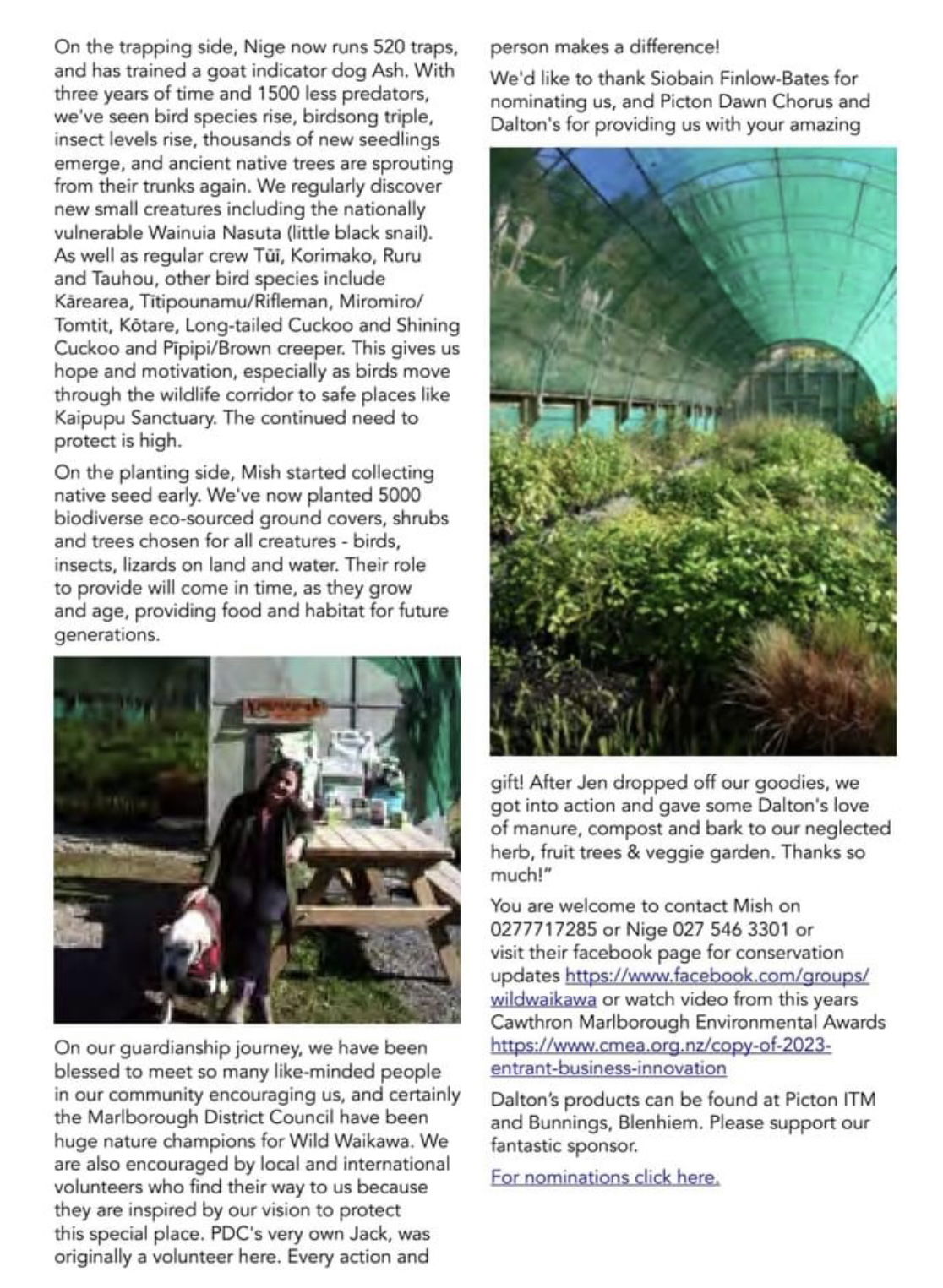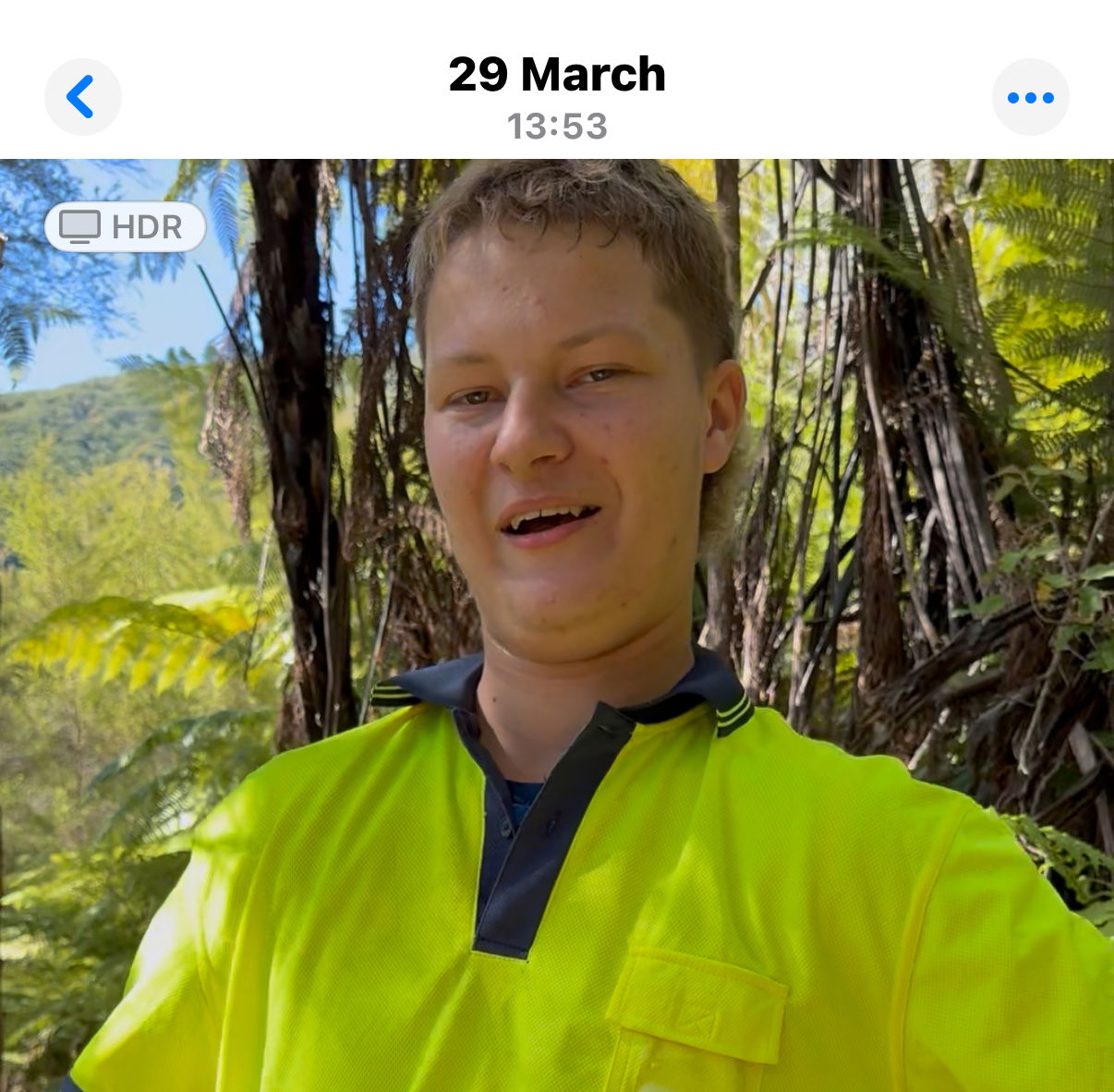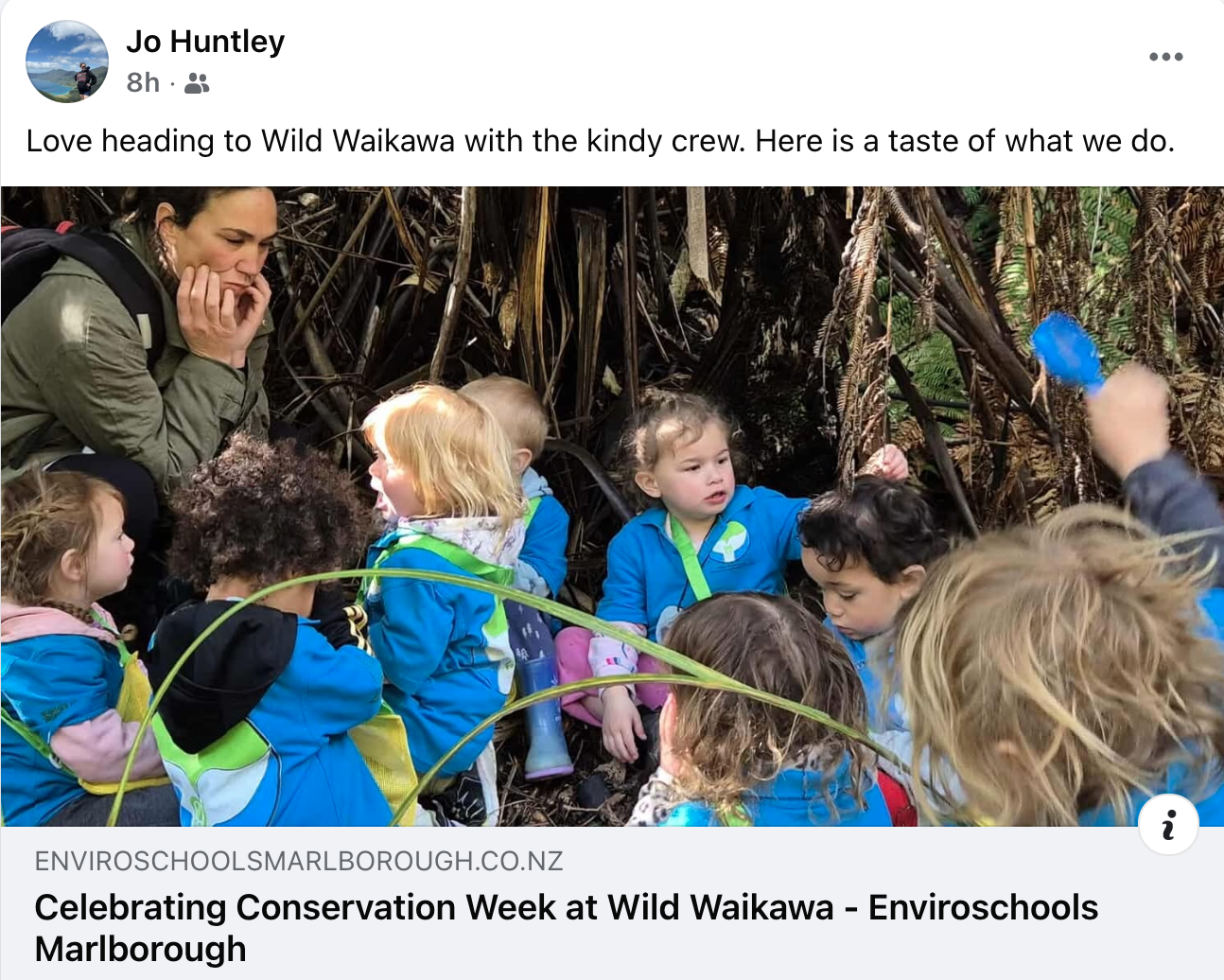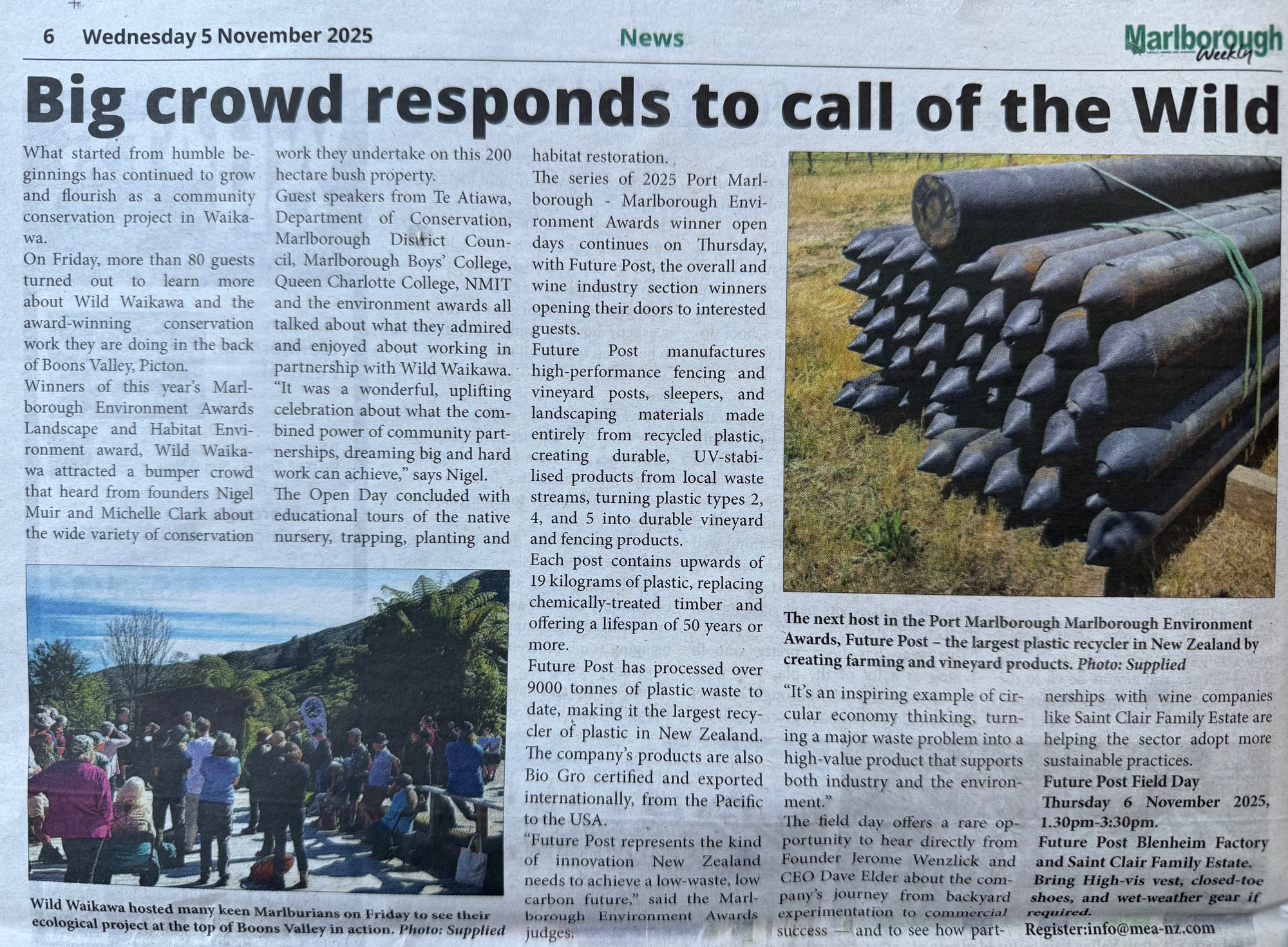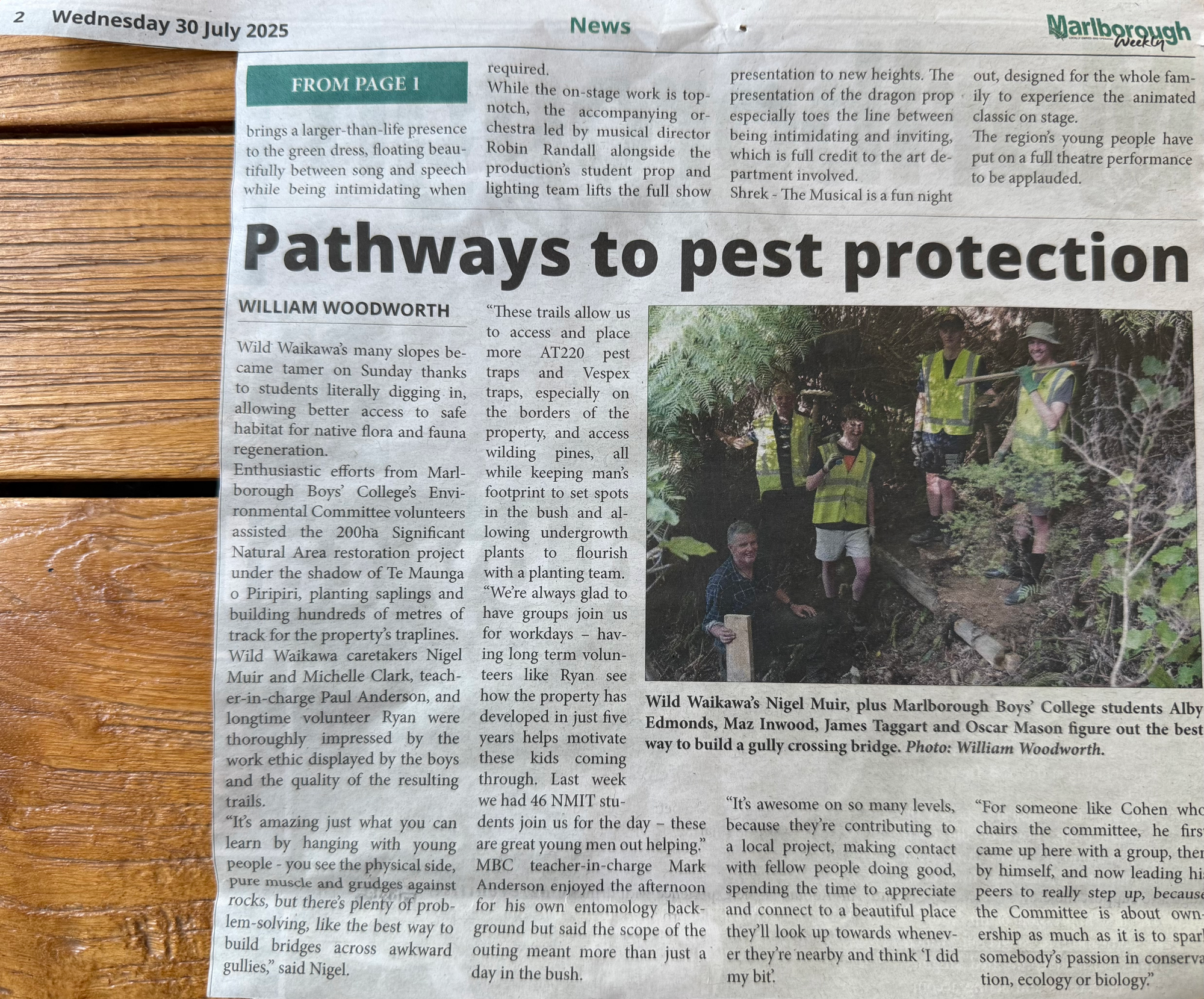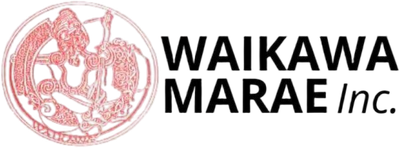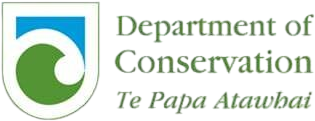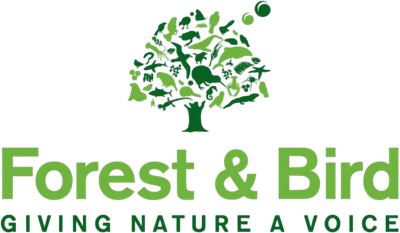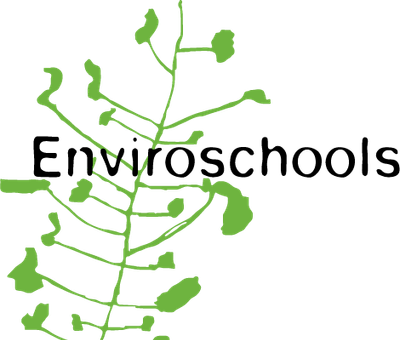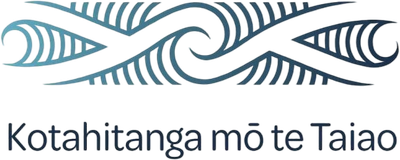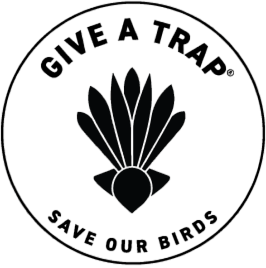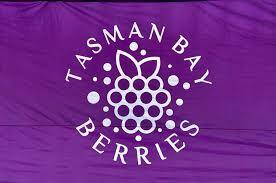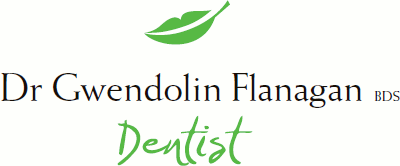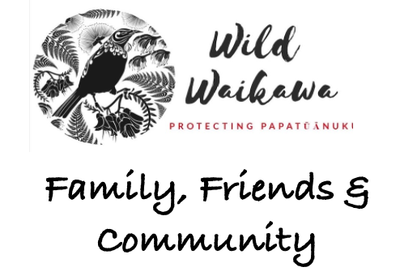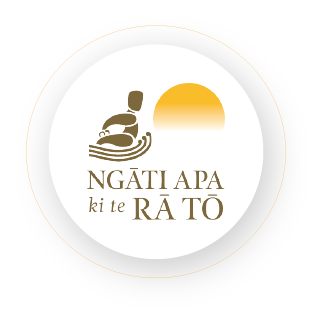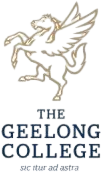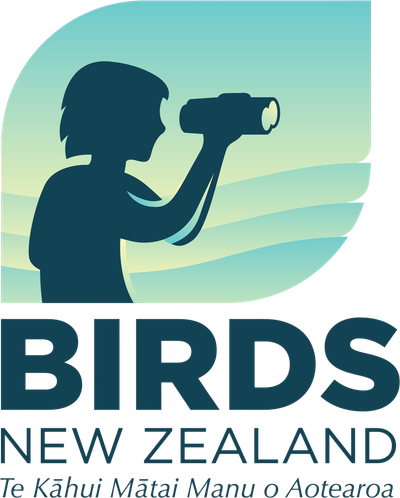"Tiakina ngā manu, ka ora te ngahere, ka ora te ngahere, ka ora ngā manu"
"Look after the birds and the forest flourishes. If the forest flourishes, the birds flourish."
This precious whenua includes Te Maunga o Piripiri, the sacred mountain of mana whenua, Te Ātiawa o te Waka-a-Maui. Covering a 200-hectare Significant Natural Area at the head of Boons Valley, Waikawa, our mission spans 400 years to recreate the ancient, natural wonderland our ancestors cherished.
Wild Waikawa won the Landscape & Habitat category of 2025 Port Marlborough Environment Award*, celebrating significant community support and participation with Te Ātiawa Iwi, Waikawa Marae, Marlborough District Council, Department of Conservation, Trees That Count and local community.
With a grass roots approach, our focus is to create a safe wildlife corridor, to deeply connect people and nature and through volunteerism make a difference locally, nationally & globally.
* https://www.mea-nz.com/landscapeandhabitat
Nature is at the Heart
Conservation
Engaging and educating the community to participate in and support our conservation efforts. Nige leads the extensive pest trapping and monitoring, trapline trail building, wasp control, and removal of wilding pines. Mish supports flora weed management, propagation and tree planting. Both Nige and Mish are involved with community conservation advocacy & volunteerism.
Nursery
Mish manages the nursery and is busy propagating native plants sourced from this beautiful lowland forest at the base of te maunga o Piri Piri. We focus on biodiversity with climbers, ground covers, shrubs and trees with over 30,000 native plants eco-sourced so far. We supply plants to Trees That Count projects and to our local business and community including Port Marlborough, Picton Dawn Chorus and schools.
Wellness
Taking time to connect with nature feels good inside and out. At Wild Waikawa we have created space amidst forest & river to restore. We offer custom designed nature wellness experiences. Mish’s life skill blend of mindset business coaching, certified health & nature care practices including Forest Bathing, EcoNIDRA™ meditation, Ecotherapy & yoga alongside next level hospitality ensures an enriching experience.
Visitors
Wild Waikawa actively hosts international volunteers including Workaway and Edventure Travel programs, in-country visitors from around the region including The Student Volunteer Army, Untouched World Foundation, NMIT Students, Marlborough Biodiversity Forum attendees, Significant Natural Area owners, as well as local community, schools and conservation advocates.
What we do
We help speed up biodiversity for conservation projects. We grow native plants & trees by eco-sourcing seed from this beautiful lowland forest at the base of te maunga o Piri Piri. We plant here at Wild Waikawa and you can call Mish for nursery orders.
Quality time exploring the Nursery
Heather from wsp consulting with Marama and Allanah Burgess, talking plant projects
https://www.wsp.com/en-nz/what-we-doMatariki Market - Waikawa Marae
Wild Waikawa's first plant sale at Waikawa Marae Night Market with Mish & Cobie.
https://www.waikawamarae.com/Marlborough Girls College propagate
@ 10 students from Marlborough Girls College successfully 'pricked out' whauwhaupaku seedlings.
https://www.mgc.school.nz/Eco-sourcing NZ Iris seed
An attractive plant with white flowers and yellow seeds.
https://www.nzpcn.org.nz/flora/species/libertia-ixioides/Dalton supplies our nursery
Daltons have been helpful with supplying pots, trays, soil, various horticultural products & advice.
https://www.daltons.co.nz/Plants heading to PDC planting day
These plants are helping re-wild Victoria Domain with later stage planting for bird food abundance - a Picton Dawn Chorus project.
https://www.pictondawnchorus.nz/Dec 2024 Untouched World Foundation Propagate
We were lucky to have 20 rangitahe visited from UTW Program. We had 4 groups divided into trail building, weeding, planting and propagation. The propagation team rocked!
https://untouchedworldfoundation.com/
2025 Landscape & Habitat Award winner for Marlborough Environment Awards, Wild Waikawa is a hands-on private sanctuary. With strong community support, we mentor conservation graduates, schools, businesses, and international groups to restore native biodiversity while fostering team-work, resilience & wellbeing. Reach out to discuss your next volunteerism event.
2023 The Geelong College
20 students and 5 teachers build a path and plant trees alomg the Waikawa Stream. Staying at Waikawa Marae as part of Edventures Travel adventure
https://edventuretravel.com.au/The Geelong College at Marae
Sept 2023 - Wild Waikawa part of welcome for The Geelong College visit at Waikawa Marae
https://www.waikawamarae.com/Waitohi Kindergarten visit
Nige & Sarah sharing about trapping. Waitohi kindy show awesome regular kaitiaki and this visit was to set up their own traps to check regularly.
https://www.marlboroughkindergartens.org.nz/waitohi-kindergartenWaikawa Bay School parents
Over school holidays, parents visit Wild Waikawa to make Harakeke balls for School fundraiser.
https://www.waikawabay.school.nz/Kaipupu Sanctuary
Hazel Ross from Kaipupu Sanctuary visits Wild Waikawa.
https://www.kaipupusanctuary.nz/Birds New Zealand -Marlborough
What passionate birders! Nige with Pat Crowe (President), Dan & Sam who recorded 28 bird species as part of Bird Atlas project.
https://www.birdsnz.org.nz/find-your-region/marlborough/CMEA Judges visit Wild Waikawa
Wild Waikawa was a Landscape & Habitat Entrant in Cawthron Marlborough Environmental Awards. Nov 2022 Judges L to R, Chris Beech, Dave Hayes, Wendy Sullivan
https://www.cmea.org.nz/May 2023 Volunteers at Forum
At Marlborough Biodiversity Forum our international volunteers help, also with Nige and Sylvie from Te Ātiawa Iwi
https://teatiawa.iwi.nz/
Taking time in nature within the many natural and nurturing spaces at Wild Waikawa. Mish is qualified in fitness & outdoor work, horticulture, ecotherapy, forest therapy/bathing, EcoNidra, Yoga including meditation and has worked for over 20 years as a mindset business coach and facilitator. Enjoy a heartfelt shift in your wellbeing. We offer a nature-based venue for groups, health professionals and day event facilitation for businesses.
2022 Forest Therapy Conference
Association of Nature and Forest Therapy (ANFT) NZ Guides hosted at Wild Waikawa.
https://www.anft.earth/EcoNIDRA™ deep rest practice
50min nature practice in shavasana (lying on back or modified as needed)
https://econidra.com/teachers-worldwideMaata Waka Wāhine Hikoi
Lowland river trail walk for wellness. Photo Credit: Mahana -twooceansmeet
https://twooceansmeet.co.nz/The Geelong College nature sensory experience
Mish leads 30 students, teachers and WW leaders connect with nature ahead of 2 day trail building & planting day organised by Edventure Travel & Waikawa Marae.
https://edventuretravel.com.au/Forest Bathing with Prime Practice
Mish welcomes Jen & Maya, business colleagues from Sydney Australia. Visiting NZ leading communication workshops & nourishing time at Wild Waikawa.
https://www.primepractice.com.au/Nature Connection Mātauranga - Enviroschools
Angela is part of the amazing group at Enviroschools supporting teachers to run nature connection sessions. Enjoying forest bathing at Wild Waikawa as part of personal development experience. Dec 2023
https://enviroschools.org.nz/regions/marlborough/Forest Bathing near Awa
Oct 2021 - Allanah General manager Waikawa Marae enjoys some restorative time.
https://www.waikawamarae.com/
Our conservation work includes trapping and predator control, wilding pine control, wasp bait placement, trapline trail making, flora weed control, propagation & planting. Every conservation act is an advocacy to support precious native treasures to thrive. Wild Waikawa is the 2025 Landscape & Habitat Winner of the Port Marlborough - Marlborough Environment Awards. https://www.mea-nz.com/landscapeandhabitat "Tiakina ngā manu, ka ora te ngahere Ka ora te ngahere, ka ora ngā manu" - "Look after the birds and the forest flourishes. If the forest flourishes, the birds flourish."
Titipounamu (Rifleman)
This little character has the distinction of been NZ's smallest bird. The size of a golfball and the weight of just six paperclips, we are delighted to see them beginning to thrive in numbers
https://nzbirdsonline.org.nz/species/riflemanMoko-piri-rakau (Forest Gecko)
This beautiful guy was discovered by my son Zac Muir while out on a Wild Waikawa adventure. He is one of 43 species of NZ gecko, all of which are nocturnal and give birth rather than lay eggs. They eat small insects, berries, honeydew and nectar.
https://rarespecies.nzfoa.org.nz/species/forest-gecko/Kōaro
This beautiful little one is found in quite good numbers throughout Wild Waikawa's rivers. Instead of scales, they have a thick, leathery skin covered with mucus. Rocky, tumbling streams are the preferred habitat of koaro, and they are almost always found in streams with native bush catchments
https://teara.govt.nz/en/photograph/11114/koaro-galaxiasbrevipinnisPūpū Rangi (Powelliphanta)
Pūpūrangi - not only does this guy have a pretty cool name, he's also one of the world's rare carnivorous snails and likes to suck up earthworms like spaghetti. Wild Waikawa has quite a population of these fascinating creatures that are at high risk from predation.
https://www.doc.govt.nz/nature/native-animals/invertebrates/powelliphanta-snails/Kōtare (Sacred Kingfisher)
The Kōtare is the only species of kingfisher that breeds in New Zealand. It only started to turn up at Wild Waikawa as the insects, dragonflies and lizards made a comeback. With beautiful electric blue plumage, we often hear them before discovering them perched on branches and rocks near the rivers. According to Polynesian legend, the Sacred Kingfisher is believed to have power over the ocean and waves.
https://www.doc.govt.nz/nature/native-animals/birds/birds-a-z/kingfisher-kotare/Harore - Funky Fungi
In the forest there are many extraordinary discoveries to be made and none more mystical than the magical world of fungi. As we control the Wilding Pines at Wild Waikawa we are seeing more and more variety of fungi. New Zealand has an estimated 20,000 species of fungi but many of these, especially the small inconspicuous ones, have not yet been studied and remain unnamed. If you're something of an expert, we would love to hear from you.
https://blog.tepapa.govt.nz/2022/03/31/fantastic-fungi-and-how-to-identify-them/Riroriro (Grey Warbler)
Everything this little character does is done with gusto. At 6.5gm it is one of our smallest, lightest birds yet is boisterous song penetrates the thickest of bushlines. Its high work ethic is probably the reason this bird is the chosen host for the shining cuckoo. A much bigger bird, during nesting, the female shining cuckoo removes a single egg from the Warbler's nest replacing it with her own egg. After hatching, the cuckoo chick ejects all grey warbler eggs and/or nestlings from the nest and is raised alone. We are yet to witness this at Wild Waikawa but with both species present it is bound to be going on in the busy forest. We will let you know once we have seen it - watch this space!
https://www.doc.govt.nz/nature/native-animals/birds/birds-a-z/grey-warbler-riroriro/Weka
The Weka can be spotted all around Wild Waikawa. This cheeky flightless individuals thrives in both the forest and lower grassland. There's not much they don't eat and have enormous curiosity often picking away food crumbs from around the dog kennels much to the disdain of the kennel inhabitants. Strong, cunning and fearless the Weka grows to about the size of a chicken and make their nests are on the ground, hiding them in thick bushes or under logs. Their nesting season is usually between August and January. Both parents help to incubate the eggs, and may lay up to 4 broods in one year. When the chicks hatch, the weka will protect them fiercely - fighting off any predators. Weka are omnivores and eat just about everything, including insects, slugs, frogs, lizards, rats, mice, eggs, small birds and they also enjoy leaves, berries and seeds.
https://www.doc.govt.nz/nature/native-animals/birds/birds-a-z/weka/Kererū (NZ Wood Pigeon)
Kererū are one of our monitor birds at Wild Waikawa. They help tell us part of the story if our restoration efforts are making a difference. We saw only one of these big, wonderful birds when we first began our trapping mahi. This year we have recorded 6 but it's slow going. Kererū are one of the world's biggest pigeons and can live for 20-30 years but only raise one chick at a time and don’t necessarily nest every year. We have a fight on our hands to help this extraordinary NZ taonga but we're up for it!
https://www.doc.govt.nz/parks-and-recreation/places-to-go/marlborough/places/queen-charlotte-sound-totaranui-area/things-to-do/tracks/queen-charlotte-track/queen-charlotte-track-stories/kereru-of-kupe/Nīkau
This small Nīkau palm is situated along one of our rivers and we use as another monitor of our mahi up here at Wild Waikawa. You can clearly see the history of predation on its leaves over the last 4 years - its newest leaves remain untouched while those from earlier years show heavy browsing. The Nīkau palm is the southernmost member of the palm family and New Zealand's only native palm species. There are over 1,100 palm species around the world, including some of the world’s most useful plants such as the oil palm, banana, coconut, and sago palm. Although a number of palms have been introduced to New Zealand, the nīkau is our only native palm species.
https://www.doc.govt.nz/nature/native-plants/nikau-palm/Tūī (Parson Bird)
A delightful songster, this special NZ bird is a common resident at Wild Waikawa. Numbers have continued to steadily grow and last year we spotted 12 Tūī in one beech tree way up at 600m. We often delight in their melodious gurgle call around the house and love it when the sun captures their majestic colours whilst in flight.
https://www.doc.govt.nz/nature/native-animals/birds/birds-a-z/tui/Moko kākāriki (green gecko)
Another beautiful, stunning find has been this wonderful gecko can live in excess of 30 years and loves to find sunny spots. Usually emerald green, we spotted this wonderful vibrant critter sunning itself in the Mānuka. Moko is a Marlborough resident and employs a wait and see foraging strategy, eating primarily invertebrates
https://www.reptiles.org.nz/herpetofauna/native/naultinus-manukanusKorimako (Bellbird)
Another one of our regulars at Wild Waikawa is this beautiful songster. Most Kiwis will recognise its call, which Captain Cook described as sounding ‘like small bells exquisitely tuned’. They are our natural morning alarm clock as they sing and chime in harmony during the early morning dawn chorus at Wild Waikawa.
https://nzbirdsonline.org.nz/species/bellbirdMiromiro (Tomtit)
We love the Miromiro at Wild Waikawa and have been delighted to discover this year their population recovery has taken them from an infrequent sighting at 800m to a regular visitor around the house. The male is so dapper in his black and white/yellow tuxedo and a busy songster throughout the year.
https://nzbirdsonline.org.nz/species/tomtitRuru (Morepork)
This watchful guardian's "morepork" call can commonly be heard in the evenings throughout Wild Waikawa. One of our most delightful encounters was whilst putting up bat monitors once Xmas eve at the 600m contour. A resident Ruru was fascinated by us and the new "toy" we were placing in its environment and swooped in on several occasions to get a closer look.
https://www.doc.govt.nz/nature/native-animals/birds/birds-a-z/morepork-ruru/Pīpīwharauroa (Shining Cuckoo)
Fancy spending the summer in Aotearoa and the winters in the Bismarck Archipelago (New Guinea) and Solomon Islands? Then you've got a kindred spirit in the shining cuckoo. It's best known for its sneaky breeding technique of laying an egg in the Grey Warbler's nest to let them foster parent their chick. We hear them a lot at Wild Waikawa over summer but they can be tricky to spot.
https://www.nzbirdsonline.org.nz/species/shining-cuckooKārearea (NZ Falcon)
When visiting Wild Waikawa you will often hear the rapid, piercing Kek-Kek-Kek hunting cry of the Kārearea as they shadow the tree canopy seeking prey. When they spy what they are after they are capable of flying at 200 km/h, and make a fast direct flying attack and either striking or grasping the prey with their feet which are equipped with sharp talons. Found only in New Zealand the Kārearea is the only endemic bird of prey left in New Zealand and is one of 38 falcon species currently recognised in the world.
https://www.doc.govt.nz/nature/native-animals/birds/birds-a-z/nz-falcon-karearea/Harore - Giant Flamecap
In terms of species, fungi far outnumber plants. Worldwide there are an estimated 1.5 million species of fungi (compared to 250,000–420,000 flowering plants). By 2004, about 7,500 species of fungi had been recorded in New Zealand. However, this is not a true reflection of the country’s fungal diversity, because many groups of fungi have not been well studied. The actual number of species is thought to be around 22,000. Over 900 species have been recorded growing with the four species of native beech.
https://www.landcareresearch.co.nz/search/?query=fungi&type=factsheetKōura (Freshwater Crayfish)
This little one was spotted walking alongside the river at 1am when we were looking for short jawed Kokopu one night with our DOC freshwater gurus. NZ has two species of Kōura. Female kōura produce eggs between April and December, and most in May and June. She carries the berry-like eggs, between 20 to 200, under the side flaps of her abdomem. Small kōura hatch about 3 to 4 months later, looking exactly like their parents in miniature.
https://www.doc.govt.nz/nature/native-animals/invertebrates/crayfish-koura/Warou (Welcome Swallow)
Under the eve of our home at Wild Waikawa we have a regular returning family of Warou. Watching these cute little, fast flying birds flit about the house is a great reminder that summer has arrived. Another self-introduced Australian we delight in the aerial antics of these welcome visitors.
https://www.nzbirdsonline.org.nz/species/welcome-swallowHarore - Red Slimy Waxgill
With a name as cool as its appearance, here's another of the autumn fungi family that inhabits Wild Waikawa's low-land forest. Amongst their many mystical roles in the forest, fungi play an important ecological role as a decomposer of wood.
https://www.inaturalist.org/posts/35101-identifying-fungi-in-new-zealandTauhou (Silvereye)
Like our beautiful Mish, this little cutey colonised NZ from Australia. We see them in great numbers at times during winter in the lowland forest. Very distinctive with its white eye-ring its name tauhou means "new arrival" and was first sited in NZ in 1832.
https://nzbirdsonline.org.nz/species/silvereyeGlow-worms at Wild Waikawa
Glowworm's Māori names are pūrātoke, from the verb "to glow", and titiwai, meaning "lights reflected in water." This likely derives from being near water where their luminous displays are reflected. This photo is taken with UVlight.
https://www.realnz.com/en/blog/everything-you-need-to-know-about-glowworms/
Planting for Weed Control
Most of our planting around the lower river area is to fill in areas that have just been weeds. It takes 3 years for plants to get big enough to hold weeds at bay. We weed every 4-6mths depending to support new plants. This garden Raf & Yoke are weeding, was planted 12mths prior.
Sept 2024 Pamela Planting deep in Forest
Pamela is a local volunteer who also has a business with her husband GIS mapping. They have helped us map weed control work - which is fantastic. Here we have hiked plants, protectors and stakes in to plant in the deep forest.
https://www.schroderhill.co.nz/conservationDec 2024 Untouched World Foundation Planting
We were lucky to have 20 rangitahe visited from UTW Program. We had 4 groups divided into trail building, weeding, planting and propagation. The planting team rocked!
https://untouchedworldfoundation.com/
Dec 2024 Untouched World Foundation
We were lucky to have 20 rangitahe visited from UTW Program. We had 4 groups divided into trail building, weeding, planting and propagation. The weeding team rocked - led here by friend and local volunteers Cobie & Sam.
https://untouchedworldfoundation.com/
Wilding conifers cover more than 1.8 million hectares of New Zealand. Despite control efforts they are spreading at an estimated rate of 5% a year. Without large scale funding and control within twenty years 20% of New Zealand will be covered with wilding pines. As wilding conifers spread across our landscapes they: reduce the numbers of plants and animals that are only found in New Zealand mpact on farming by significantly reducing the available grazing land create a fire risk as they are dense and impenetrable with no road access limit recreation and tourism related activities can cause acidification of soils which leads to the depletion of some minerals such as calcium use more water, so runoff is decreased which affects streams in the catchment release large volumes of water vapour to the atmosphere through their leaves provide habitat for exotic pest plants, animals and diseases.
Removing young pines
Nigel in action with his Silky Saw, removing yet another young wilding pine. Each year thousands of young seedling plants are removing at Wild Waikawa - we estimate it will take another 7 years to removing the young wildings that spring up from dormant pinecone seeds in the ground.
https://www.doc.govt.nz/nature/pests-and-threats/weeds/common-weeds/wilding-conifers/#:~:text=As%20wilding%20conifers%20spread%20across,impenetrable%20with%20no%20road%20accessWilding Pines cause acidification of soils which leads to the depletion of some minerals such as calcium. This combined with their higher demand for water than native plants leads to large areas of barren land such as that pictured. Its remarkable to see how the native bush springs back to life once the wilding pines are removed.
New Zealand faces one of the highest densities of German and common wasps globally. Wasps are a major problem in beech forests where they consume massive amounts of honeydew, an important food for native birds, bats, insects and lizards. Wasps also eat huge numbers of native insects and have even been seen killing newly hatched birds. By eating so much, they upset the natural food chain of the forest.
Wasp Control
Seasonally in some beech forests there are an estimated 12 nests, or 10,000 worker wasps, per hectare. This makes the total combined body-weight of wasps in these areas higher than the weight of all native birds, stoats and rodents, put together.
https://www.doc.govt.nz/nature/pests-and-threats/animal-pests-and-threats/wasps/
Highlights
Media Gallery
Stories and videos about the amazing work going on at Wild Waikawa
Our Supporters
We are incredibly humbled & grateful for continued community support. Your actions enrich the health and vitality of te taiao for generations to come. Nga mihi ki a koutou / Thank you
Join Us
Contact us
- Waikawa, New Zealand
- PO Box 523 Picton 7250
- +64-0277717285 - Welcoming enquiries
- mish@wildwaikawa.co.nz
- Community, Conservation & Nursery Visits welcomed by appointment.
Contact Nige for trapping & relationship enquiries: +64 27546 3301 email: reach.nmuir@gmail.com Call Mish for nursery orders, private nature tours, volunteerism, community, guest speaking: +64 27 771 7285 Contact Dawn for admin or marketing initiatives: +64 27 642 2882, dawn@wildwaikawa.co.nz
